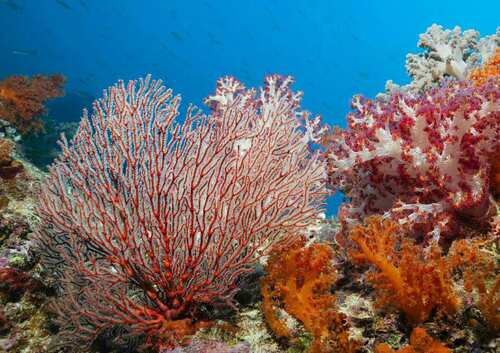When we talk about the ocean, corals are often associated with beautiful underwater scenes and colorful coral reefs. Coral reefs are home to a variety of marine life and have a rich ecosystem. However, many people often misunderstand the nature of corals, thinking that they are plants or inanimate stones. So, what exactly are corals? The answer is that corals are animals.,And it is a very special marine invertebrate.

1. Basic concepts of coral
Corals are a class of marine invertebrates belonging to the phylum Cnidaria, and are close relatives of jellyfish, sea anemones, and other organisms. Corals are composed of thousands of individual small organisms - coral polyps .(coral polyps)These small organisms have a simple body structure consisting of a mouth, tentacles, and a stomach cavity. Each coral polyp obtains food by catching tiny plankton with its tentacles.
Although individual coral polyps are very tiny, they gather together in the thousands to form huge coral colonies. Each coral polyp secretes a hard calcium carbonate skeleton, which together form the coral reef structure we see on the seabed.
Nutrition: Corals are heterotrophs, meaning they cannot make their own food through photosynthesis. Coral polyps obtain nutrients by feeding on plankton in the ocean. This is a significant difference from plants, which are autotrophs that generate energy through photosynthesis.
Physiological structure : Coral polyps have a simple nervous system, mouth, stomach cavity and tentacles, typical animal structures that help them hunt and digest food. Each coral polyp captures prey through the cnidocytes of its tentacles and then sends it to its mouth for digestion.
Reproduction method : Corals can reproduce through two methods: asexual reproduction and sexual reproduction . Asexual reproduction allows coral polyps to form new individuals through division, which helps the rapid expansion of coral reefs. In sexual reproduction, corals release sperm and eggs to form larvae (planula). These larvae will attach to the seabed after swimming for a period of time and gradually develop into new coral colonies.
Although corals are animals, they have a close symbiotic relationship with plants. The coral polyps in coral reefs are often inhabited by tiny single-celled algae called zooxanthellae. Zooxanthellae provide corals with a large amount of energy through photosynthesis, and the energy produced by these algae can meet 70-90% of the coral's nutritional needs. This symbiotic relationship is essential for the survival of corals, especially in tropical waters where nutrients are scarce.
Due to the presence of zooxanthellae, corals tend to live in shallow waters, and the algae need plenty of sunlight for photosynthesis. Therefore, corals usually grow in tropical or subtropical oceans with warmer water temperatures and plenty of sunlight.
Corals form strong exoskeletons by secreting calcium carbonate, which accumulate over time and eventually form huge coral reef structures. Coral reefs are called "tropical rainforests in the ocean" because they provide habitat and food for a variety of marine life. Coral reefs have a huge impact on marine ecosystems, mainly in the following aspects:
Biodiversity : Coral reefs are one of the most biodiverse ecosystems on Earth. Although they cover less than 1% of the ocean surface, they provide habitat for more than 25% of marine life. Fish, shellfish, invertebrates and algae all find a suitable living environment in coral reefs.
Ecological barrier : Coral reefs also act as natural barriers, slowing down the force of waves, protecting coastal areas from storms and tsunamis, and reducing coastal erosion.
Fisheries : Many fisheries rely on coral reefs as important fishing grounds. Coral reef ecosystems support a variety of economically important fish species and serve as an important food source for coastal communities.
While coral reef ecosystems are vital to the ocean, they face multiple threats, primarily climate change, pollution and overfishing.
Climate change : Global warming has led to rising sea temperatures, which is extremely detrimental to the survival of corals. High temperatures can cause coral bleaching , which means that the symbiotic relationship between corals and zooxanthellae is destroyed, causing the corals to lose their color and eventually die.
Ocean acidification : As carbon dioxide in the atmosphere increases, the ocean absorbs more carbon dioxide, causing the seawater to become more acidic. Acidified seawater weakens the ability of corals to secrete calcium carbonate skeletons, directly affecting the formation and stability of coral reefs.
Pollution and overfishing : Marine pollution (such as plastic waste, pesticides and heavy metals) and overfishing have also taken a heavy toll on coral reefs. Pollutants can affect coral growth, while destructive fishing methods such as blasting and trawling directly damage coral structures.
To protect corals and their habitats, various conservation measures are being taken around the world:
Establish marine protected areas : By designating marine protected areas, human activities can be restricted to prevent overfishing and pollution, and protect coral reef ecosystems.
Reducing carbon emissions : A key measure to address climate change is to reduce greenhouse gas emissions, slow the rate of global warming, and thus reduce the pressure on corals.
Ecological restoration : In some areas, scientists are restoring damaged coral reefs by artificially growing corals. These "coral farms" help cultivate and grow new corals to restore damaged ecosystems.
Public Awareness Education : Raise public awareness of the importance of coral reef ecosystems, encourage environmentally friendly behaviors such as reducing plastic use, avoiding destructive fishing, and promote coral conservation.
Corals, although they may look like plants or rocks, are actually living animals. They survive through a symbiotic relationship with algae and provide irreplaceable support to marine ecosystems around the world. However, coral reefs are currently facing serious threats. Protecting coral reefs is not only to maintain biodiversity in the ocean, but also to protect the marine resources and environment on which we humans depend. The role of corals as animals reminds us of the interconnectedness and interdependence of everything in nature.
animal tags: coral
We created this article in conjunction with AI technology, then made sure it was fact-checked and edited by a Animals Top editor.